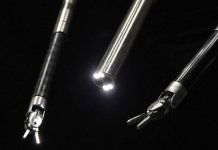
Quantum computers have the potential to solve incredibly complex problems that even the world’s most powerful supercomputers can’t handle.
To achieve this, quantum computers need millions of tiny building blocks called qubits. However, making and controlling so many qubits is a huge challenge.
Researchers at MIT and MITRE have made a big step towards this goal. They created a new, scalable hardware system that can handle thousands of qubits on a single chip.
This system, called a “quantum-system-on-chip” (QSoC), can precisely control and connect a large number of qubits, allowing multiple chips to link together using optical networking.
This could create a large-scale quantum communication network.
The team, led by MIT graduate student Linsen Li, developed a special process to create two-dimensional arrays of tiny qubit chips and place thousands of them onto a customized integrated circuit (IC) in one step.
These qubit chips are made from diamond color centers, a type of artificial atom that stores quantum information.
Diamonds are chosen because they can be made using modern semiconductor techniques, are compact, and have stable quantum properties.
Diamond color centers have a unique advantage: each one has its own spectral frequency, like a unique radio station.
This allows scientists to tune each qubit individually using lasers, overcoming a challenge in making large numbers of qubits work together.
The researchers created a CMOS (complementary metal-oxide semiconductor) chip with tiny sockets that match up with the diamond qubit chips.
Using a lock-and-release method, they placed thousands of these diamond chips into the sockets in a single step. This process involved fabricating an array of diamond color centers, designing nanoscale optical antennas for better photon collection, and post-processing a CMOS chip to add microscale sockets.
In their tests, the researchers successfully transferred an array with 1,024 diamond nanoantennas onto a 500-micron by 500-micron area of the CMOS chip. They found that as the number of qubits increased, less voltage was needed to tune the frequencies, making the system even more efficient.
The team also developed a special setup to test and measure the performance of their QSoC. They showed that over 4,000 qubits could be tuned to the same frequency while maintaining their quantum properties.
They also created a digital twin simulation to better understand the system and improve its design.
In the future, the researchers aim to enhance their system by refining the materials used for the qubits and improving control processes. They also plan to apply this technology to other quantum systems.
This new approach could be a major step forward in building large-scale quantum computers, bringing us closer to unlocking their incredible potential.



